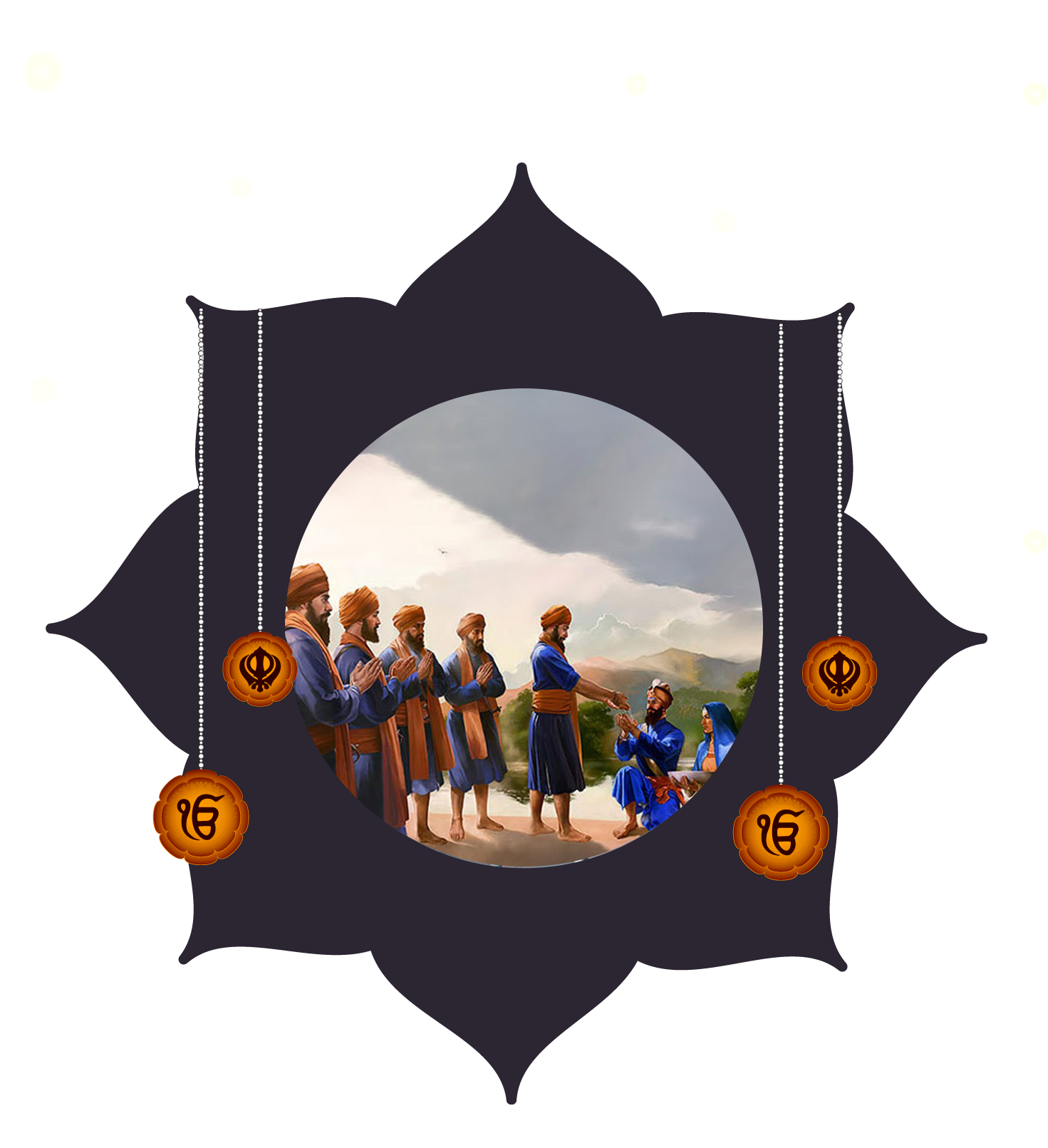
The Panj Pyare is the Sikh word for the Five Beloved: the men who were inducted into the khalsa (the Sikh brotherhood) under the guidance of the last of the ten Gurus, Guru Gobind Singh. Sikhs hold the Panj Pyare in high regard as symbols of endurance and devotion.
Following the death of his father, Guru Tegh Bahadur, who refused to convert to Islam, Guru Gobind Singh was proclaimed Guru of the Sikhs, according to tradition. Sikhs fleeing Muslim oppression at this point in history frequently returned to Hindu worship. To preserve the tradition, Guru Gobind Singh requested five men willing to give their life for him at a community meeting. Despite widespread hesitation, five volunteers stepped forward and were admitted into the khalsa—the exclusive group of Sikh warriors.
The original five beloved Panj Pyare were instrumental in establishing Sikh history and defining Sikhism. These spiritual warriors promised not only to fight enemies on the battlefield, but also to fight the inner adversary, egoism, with humility by serving humanity and working to eradicate caste. On the occasion of the Vaisakhi festival in 1699, they performed the initial Amrit Sanchar (Sikh initiation ceremony), baptising Guru Gobind Singh and over 80,000 people.
To this day, each of the five Panj Pyare are venerated and meticulously studied. All five Panj Pyare fought alongside Guru Gobind Singh and the Khalsa at the siege of Anand Purin and assisted the guru in escaping the fight of Chamkaur in December 1705.
Bhai Daya Singh was the first of the Panj Pyare to respond to Guru Gobind Singh's appeal and sacrifice his head. Daya Singh was born in Lahore in 1661 as Daya Rum (present-day Pakistan)
Family: Son of Suddha and his wife Mai Dayali of the Sobhi Khatri clan
Occupation: Shopkeeper
Initiation: at Anand Purin 1699, at age 38
Death: at Nanded in 1708; martyred age 47
Upon initiation, Daya Ram abandoned his occupation and Khatri caste alliance to become Bhai
Daya Singh and join the Khalsa soldiers. The name "Daya" means "merciful, generous, and
compassionate," and Singh means "lion"—qualities shared by the five adored Panj Pyare, all of
whom have this name.
Bhai Dharam Singh was the second Panj Pyare to respond to Guru Gobind Singh's appeal. Dharam Dasin was born in Hastinapur, northeast of Meerut, in 1666 along the Ganges (present day Delhi)
Family: Son of Sant Ram and his wife Mai Sabho, of the Jatt clan
Occupation: Farmer
Initiation: at Anand Purin in 1699, at age 33
Death: At Nanded in 1708; martyred age 42
Dharam Ram left aside his employment and Jatt caste connection upon initiation to become Bhai Dharam Singh and join the Khalsa warriors. The word "Dharam" means "righteous living."
Bhai Himmat Singh was the third of the Panj Pyare to respond to Guru Gobind Singh's invitation. Himmat Rai was born on January 18, 1661, in Jagannath Puri as Himmat Rai (present-day Orissa)
Family: Son of Gulzaree and his wife Dhanoo of the Jheeaur clan
Occupation: Water carrier
Initiation: Anand Pur, 1699. Age 38
Death: At Chamkaur, December 7, 1705; martyred age 4
Himmat Rai left up his occupation and Kumhar caste connection upon initiation to become Bhai Himmat Singh and join the Khalsa soldiers. The word "Himmat" means "courageous spirit."
Bhai Muhkam Singh was the fourth person to respond to Guru Gobind Singh's appeal. Muhkam Chand was born on June 6, 1663, in Dwarka (present-day Gujrat)
Family: Son of Tirath Chand and his wife Devi Bai of the Chhimba clan
Occupation: Tailor, printer of cloth
Initiation: at Anand Pur, 1699 at age 36
Death: Chamkaur, December 7, 1705; martyred age 44
Muhkam Chand left up his occupation and Chhimba caste alliance upon initiation to become Bhai Muhkam Singh and join the Khalsa warriors. "Muhkam" means "strong, firm leader or manager." Bhai Muhkam Singh fought alongside Guru Gobind Singh and the Khalsa in Anand Pur and died in the battle of Chamkaur in December.
Bhai Sahib Singh was the fifth person to respond to Guru Gobind Singh's appeal. On June 17, 1663, Sahib Chand was born in Bidar as Sahib Chand (present-day Karnataka, India)
Family: Son of Bhai Guru Narayana and his wife Ankamma Bai of the Naee clan.
Occupation: Barber
Initiation: at Anand Pur in 1699, at age 37
Death: at Chamkaur, December 7, 1705; martyred age 44.
Sahib Chand put aside his occupation and the alliance of his Nai caste upon initiation to become Bhai Sahib Singh and join the Khalsa soldiers. The term "Sahib" means "lordly or masterful." On December 7, 1705, Bhai Sahib Sigh gave his life in defence of Guru Gobind Singh and the Khalsa at the battle of Chamkaur.